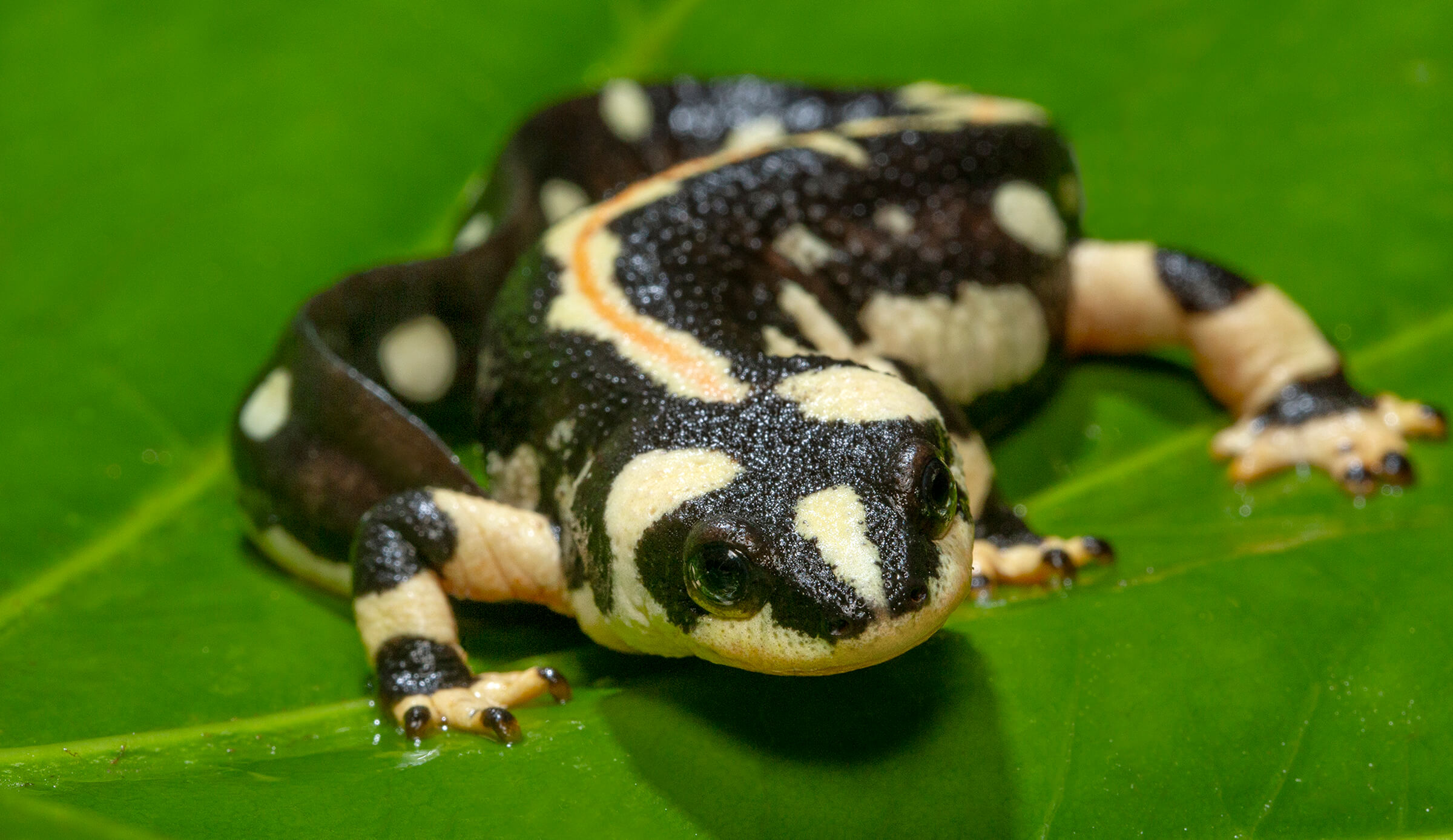
Unseen Heroes
You may not see a salamander in your backyard, but one may have visited—and it might even live there now.
BY Eston Ellis
Photography by Ken Bohn
Salamanders stay out of the view of most humans, and most only come out at night. That’s when conditions are right, with enough moisture to maintain their skin and provide shallow pools or moist substrate for breeding and laying eggs. Even though one of their best-known features is their cool, moist, frog-like skin, salamanders get their name from a Persian phrase meaning “the fire within.” From the days of ancient Rome through the Middle Ages, legends persisted that salamanders were born from fire, thrived in fire, and could extinguish flames with their bodies. None of that was true, of course. Those legends stemmed from the fact that when logs were gathered and thrown onto a bonfire, salamanders that had been hiding among the logs escaped by running out through the flames.
While they may not be wizards of fire, salamanders—which includes newts—can do some pretty remarkable things. Some salamanders can regenerate a tail, a toe, or an entire limb, if injured. Some species can produce toxins that will sicken or kill a predator that eats it, or cause skin irritation to a person who touches one. Some have lungs, some have gills, some have both, and some breathe through their skin. Some live their entire lives in dark caves; some live entirely in water; and some are active only during wet, rainy months, then burrow underground and go into a state of torpor during extremely cold or hot, dry months.
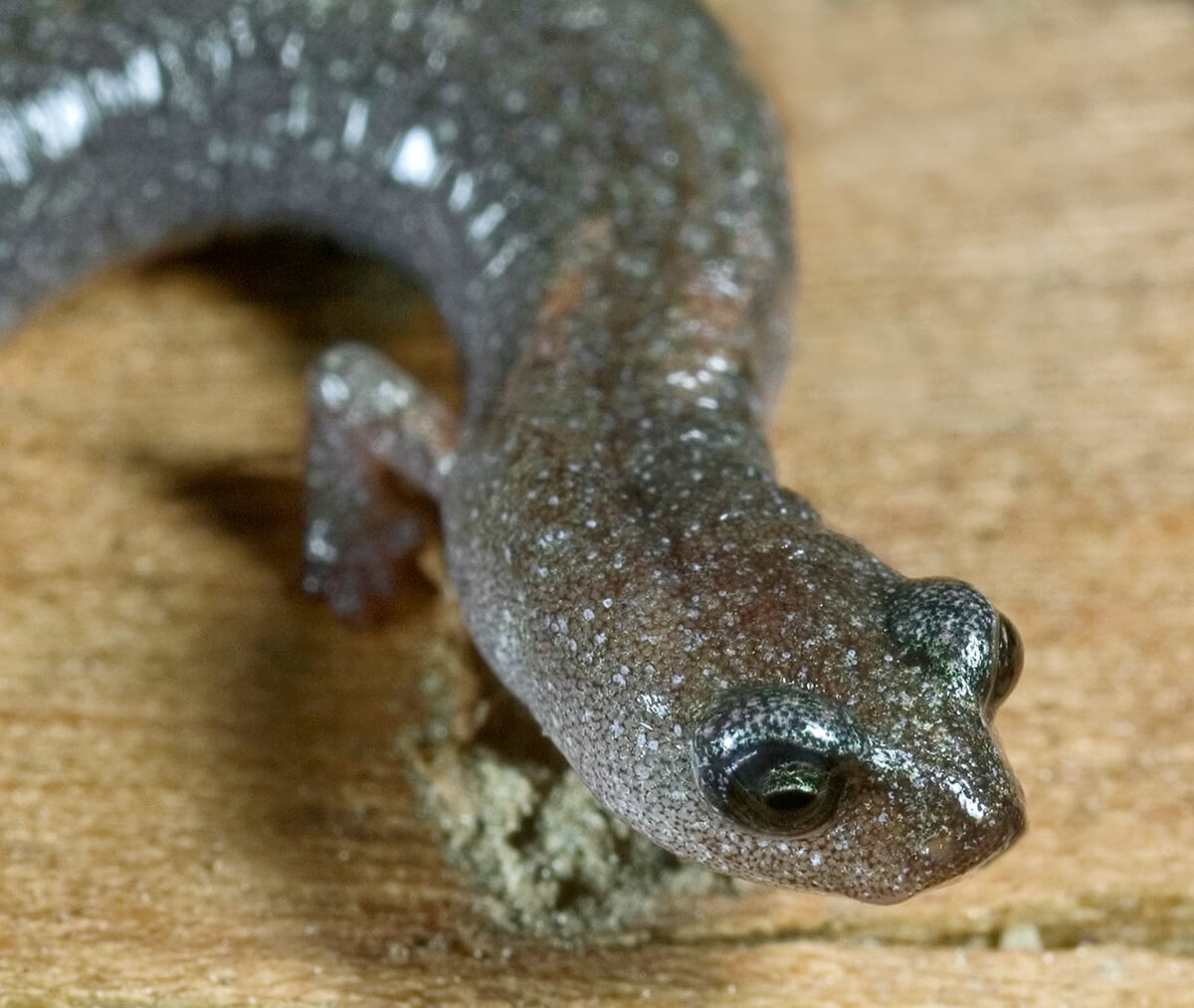
NOT A WORM
The garden slender salamander is just two to three inches in length—and backyard gardeners who only see its tail sometimes mistake this tiny amphibian for an earthworm. (Photo by: Design Pics/Getty Images)
There are about 600 salamander species, in 9 families and 60 genera. They range from less than an inch in length (the 0.6-inch Thorius arboreus) to more than 5 feet (the Chinese giant salamander Andrias spp.), although most salamanders average around 6 inches in length. Many do not produce sounds, but they can sense vibrations. Most salamander species have four legs, but some, including the eel-like sirens (Family Sirenidae) that spend their entire lives in the water, have two legs.
Salamanders typically lay eggs, either in the water or on land, which they guard until they hatch. A few species are ovoviviparous: females hold their eggs internally until offspring are full term or fully developed, and then they give birth. When the majority of salamanders hatch from the egg they are in a larval stage, known as an eft. But some species, including lungless salamanders, skip the larval stage entirely, and small, fully formed salamanders emerge from the eggs. Perhaps most strange of all, another species, the axolotl Ambystoma mexicanum, spends its entire life in the larval stage.

IN THE TREETOPS
The arboreal salamander has gripping toes that are built for tree climbing, and sharp teeth to defend themselves from predators. (Photo by: Design Pics/Getty Images)
While North America has the largest number of salamander species—nearly half of them—salamanders are found all over the world, on every continent except Australia and Antarctica. While most people never see one, in some forests there are more salamanders than any other vertebrate species.
For an animal that is typically small, salamanders make a surprisingly big impact on their environment. Most eat insects, helping to keep invertebrate populations in check. In forests, salamanders eat beetles, worms, ants, snails, slugs, and other animals that feed on leaves. Eating the leaf-eaters reduces the amount of carbon that is released when these animals consume leaves—and it increases the amount of leaf litter on the forest floor, ultimately increasing soil nutrients.
“San Diego County has four species of salamanders and newts,” said Brett Baldwin, associate curator of herpetology and ichthyology at the San Diego Zoo. Three of them are members of the family Plethodontidae, or lungless salamanders, which take in oxygen through their skin. There is one introduced species, the western tiger salamander, a mole salamander from the Ambystomtidae. “Like frogs, because they respire through their skin, salamanders are important indicator species—like the canary in the coal mine. They are incredibly sensitive to toxins in their environment.”
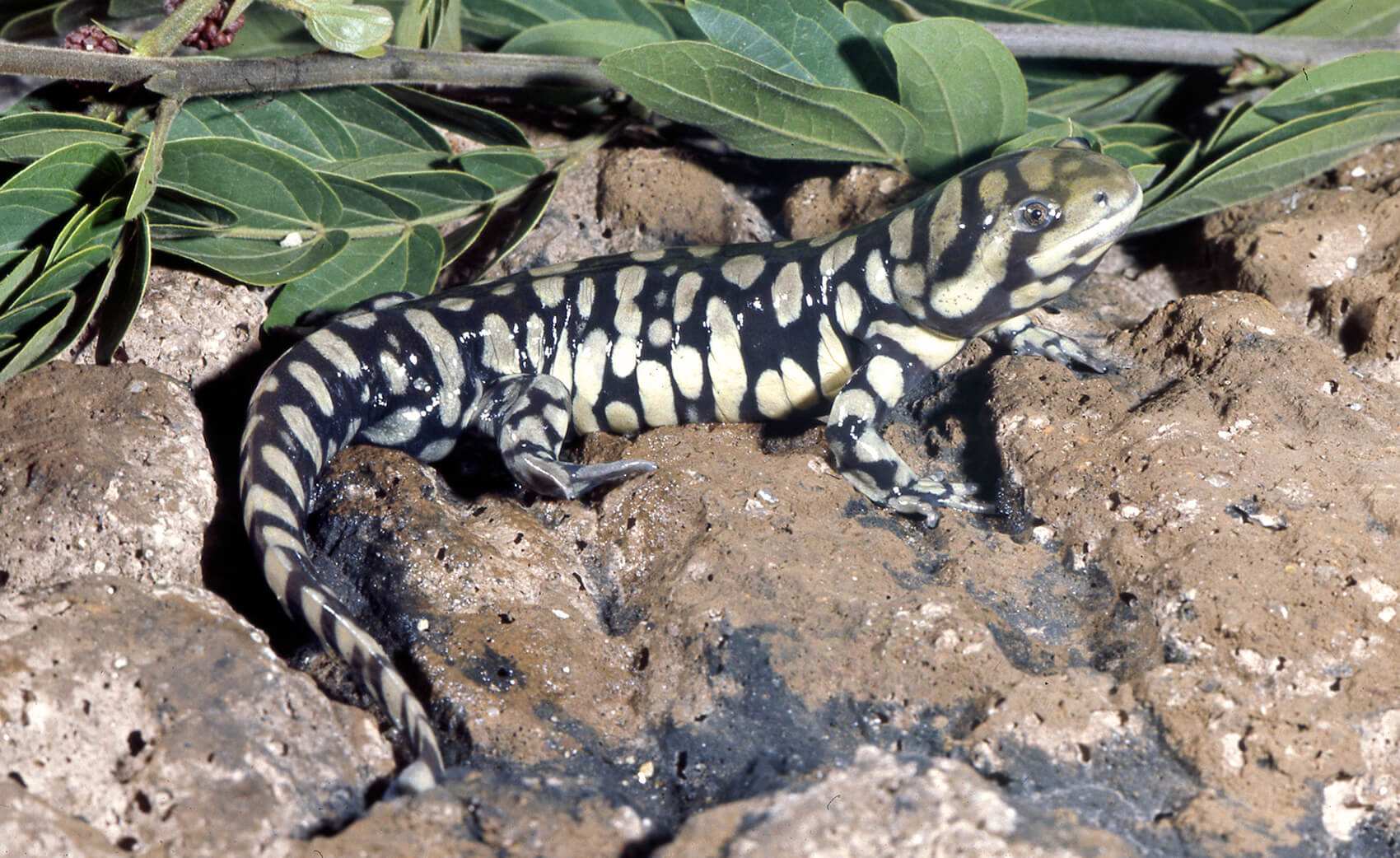
RIGHT PLACE, RIGHT TIME
You have to be in just the right place at exactly the right time to spot a salamander like this North American tiger salamander, which spends most of the year burrowed underground, emerging only when conditions are right—usually after heavy rains.
Other species you might see in San Diego County include the arboreal salamander Aneides lugubris, which can climb 60 feet high in tree canopies. It also has teeth—and a strong bite. There’s the ensatina Ensatina eschscholtzii, whose reddish color warns potential predators of the toxins it produces. The tiny garden slender salamander Batrachoseps major is frequently found in backyards. Although it has a salamander’s shape and four legs, it is often mistaken for an earthworm, because of its size. The California newt Taricha torosa, classified as a California Species of Special Concern, lives in coastal areas and coastal range mountains, has a distinctive golden belly, and produces a powerful toxin to deter predators.
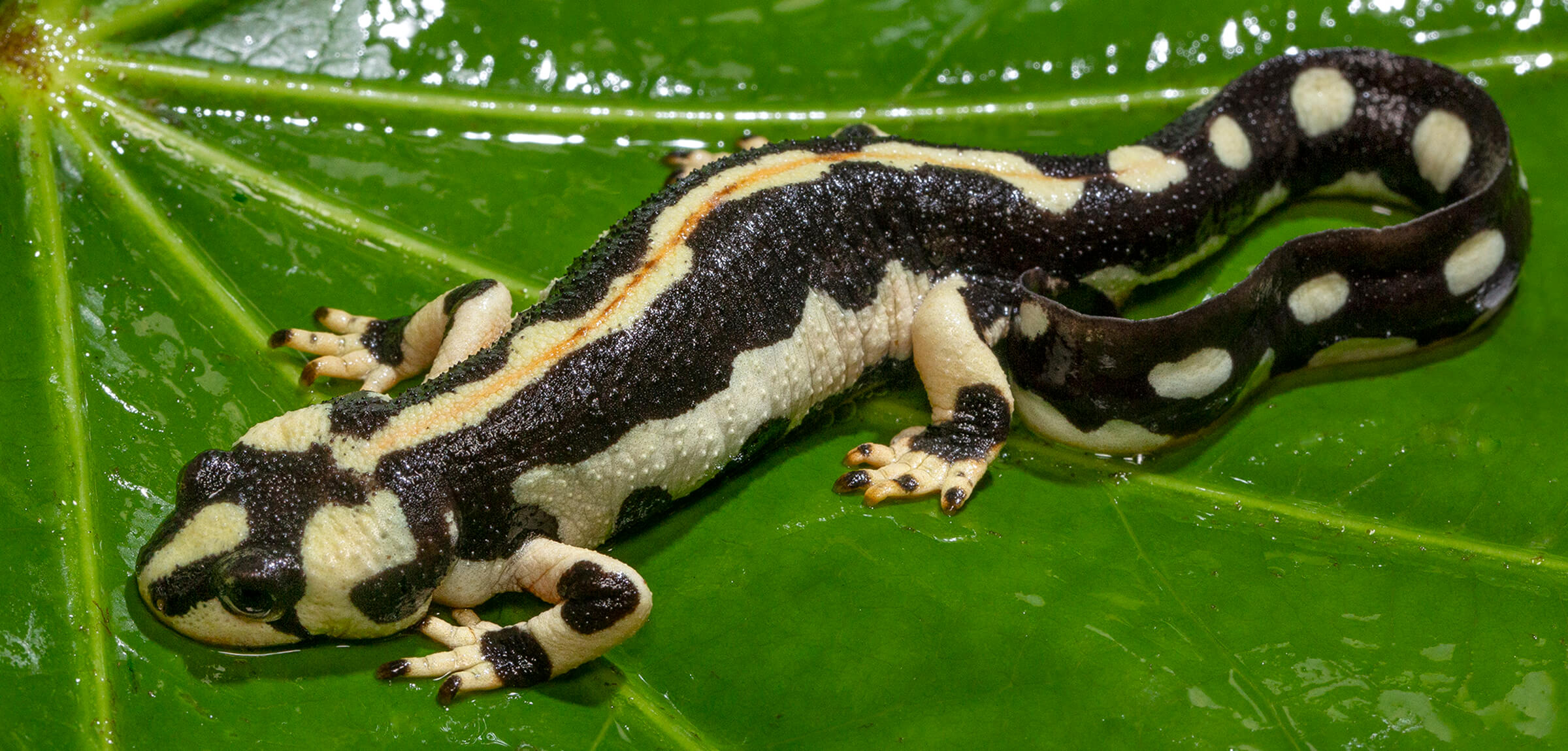
At the Zoo
Guests at the San Diego Zoo can see two especially colorful salamander species at the Reptile Walk Amphibian Building: European fire salamanders Salamandra salamandra and Kaiser newts Neurergus kaiseri.
“European fire salamanders are amazing,” said Peter Alexander, reptile and amphibian keeper. Named for its distinctive black-and-orange coloration, the fire salamander was the first salamander species known to Western science. Its bright color indicates its ability to produce toxins through glands on its body and behind its eyes—and it can also spray toxins to discourage predators before an attack. The Zoo currently has nine fire salamanders, about six to seven years old, and all were born here—the fire salamander is one of the ovoviviparous species.

BLAZING COLORS
The distinctive orange-and-black European fire salamander was the first salamander species identified by Western science. Despite its name, the legend that it is impervious to fire is untrue.
The Kaiser newt is a salamander species native to Iran’s Zagros Mountains. “The population of this species started to decrease dramatically, when they were smuggled out for the pet trade,” Brett said. “A couple of zoos got a few Kaiser newts and decided to breed large numbers of them—in an effort to crash the illegal demand in the pet trade and to maintain an assurance population of the species. There are still low numbers in the wild, but there are now many in zoos, including ours—so many that we don’t breed them anymore.”
In its native habitat, the black-and-white or black-and-yellow striped and spotted Kaiser newt spends the drier part of the year—about eight months—estivating under logs or rocks, Peter said. “Once spring returns, they migrate and wait for temporal streams to arrive, for breeding. In our exhibit, they have vegetation and a pool year round, but they also have rocks and structures away from the water. At any given time, it’s interesting to see which ones choose to be on land and which ones are in the water.”

A SALAMANDER SURVIVOR
While fewer than 1,000 mature Kaiser newts are believed to remain in their native habitat in Iran’s Zagros Mountains, breeding programs at zoos around the world have helped build a healthy assurance population of this species.
Kaiser newts are also known for their “courtship dance,” Peter explained. Males undulate their tail to attract a mate. When a female’s interest is piqued, “the male will go in front of the female and drop a spermataphore, or sperm packet, in the water, kind of like a gift, and she will take it.”
Behind the scenes at Reptile Walk, the Zoo has a well-cared-for, 22-year-old spotted salamander Ambystoma maculatum. The life expectancy for this species is 20 to 30 years, Peter explained. “She is doing well, and sometimes she gets her cricket meal hand fed—which is more for my peace of mind than hers.” Because of its potential to compete and possibly hybridize with the vulnerable population of California tiger salamanders, the spotted salamander is considered a detrimental species in California. However, spotted salamanders are found from Canada to Florida. They are another type of mole salamander, which spend most of their life underground.
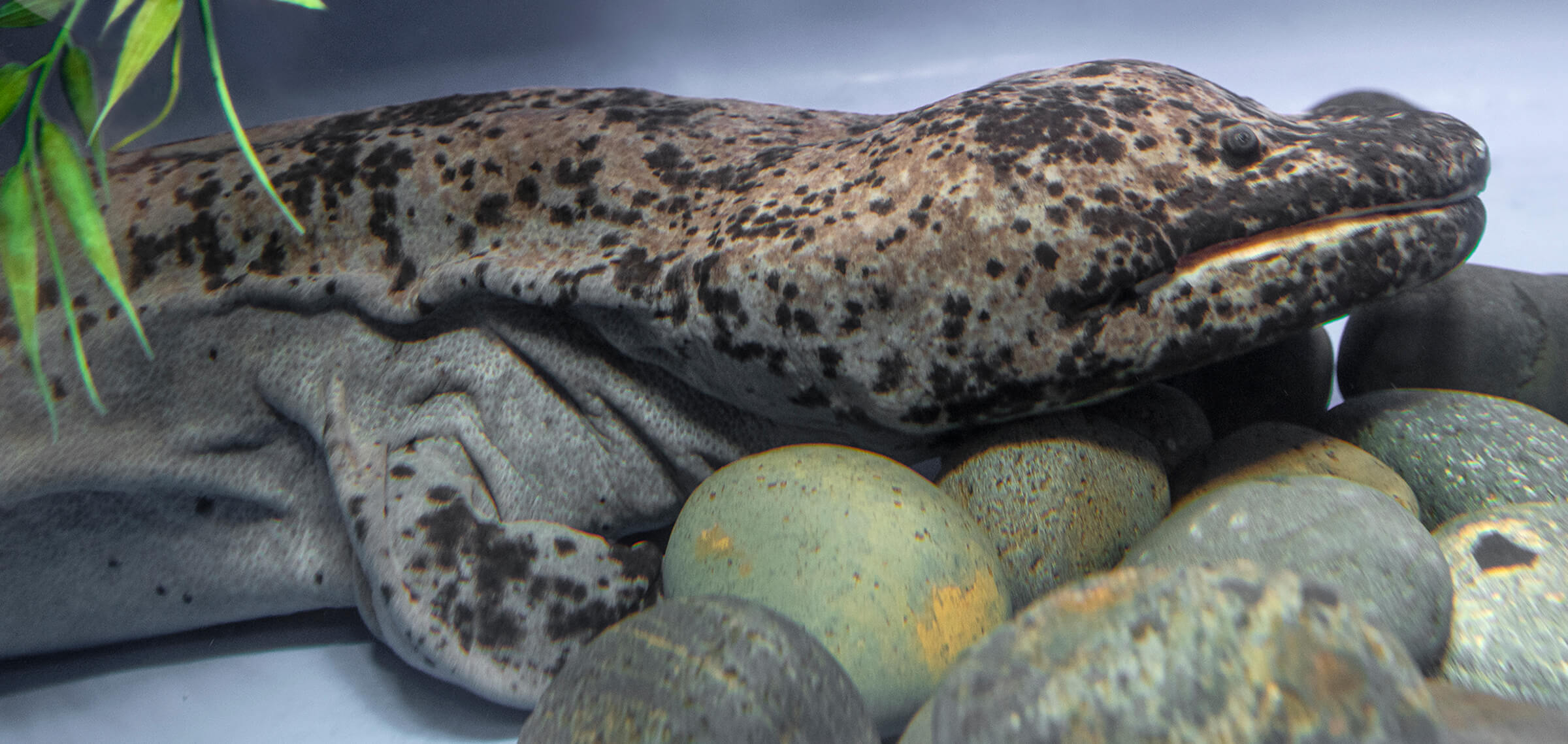
The Giants
In 2021, when the Zoo’s new Denny Sanford Children’s Zoo opens, guests will get an opportunity to see a new exhibit with a truly unique salamander species: the Chinese giant salamander. This salamander definitely lives up to its name: it is the world’s largest amphibian species, with some individuals growing to more than 5 feet in length and weighing up to 110 pounds.
Currently, the Zoo’s three Chinese giant salamanders—named Stumpy, Sau York, and Tai Fa—are living off exhibit in their own building, each in its own tank with temperature-controlled water and biofiltration systems, and a large pipe-like structure used as a den.
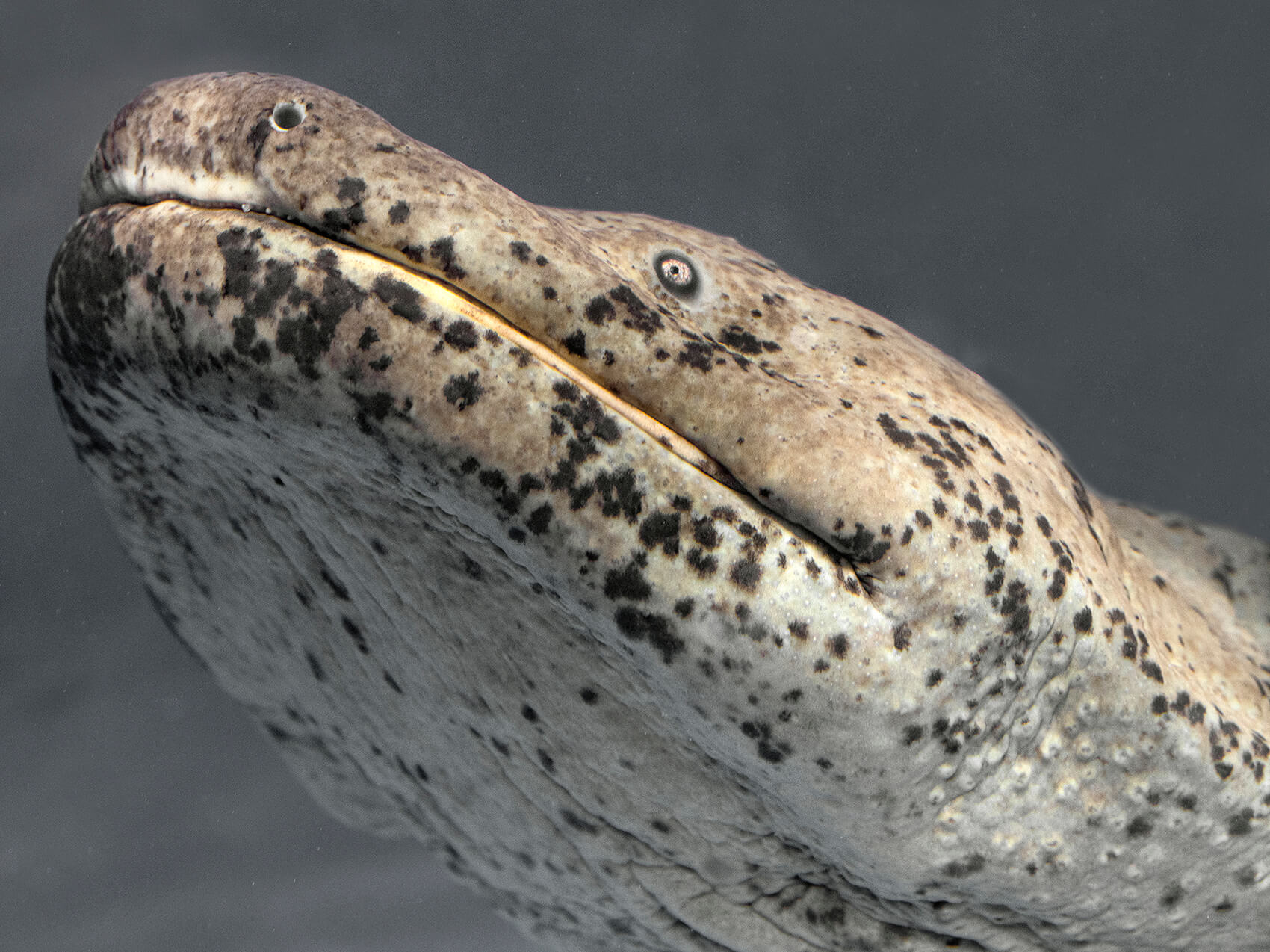
LIVE STREAMING
Chinese giant salamanders, which can can grow to more than five feet in length, spend their entire lives in mountain streams.
Our Chinese giant salamanders currently measure about four feet in length from tail to nose, but they are only seven years old—and there’s a lot of growing time ahead. Some individuals of this entirely aquatic species are known to live 50 years or more. In the rocky, mountain streams of their native habitat in China, they eat fish, crustaceans, earthworms, and insects. At the Zoo, our Chinese giant salamanders eat earthworms, thawed frozen fish, and crayfish.
The wild population of Chinese giant salamanders is classified as Critically Endangered by IUCN, as the species has been harvested for years as a popular food item in China. The diminishing wild population led the Chinese government to encourage aquaculture: farming of the species to satisfy the continued culinary demand for Chinese giant salamanders. However, Brett explained that there has been a recent attempt to reintroduce some young salamanders back into the wild that proved to be somewhat successful but hopeful. “They shouldn’t be considered an assurance colony and can’t be released in the wild,” Brett noted.
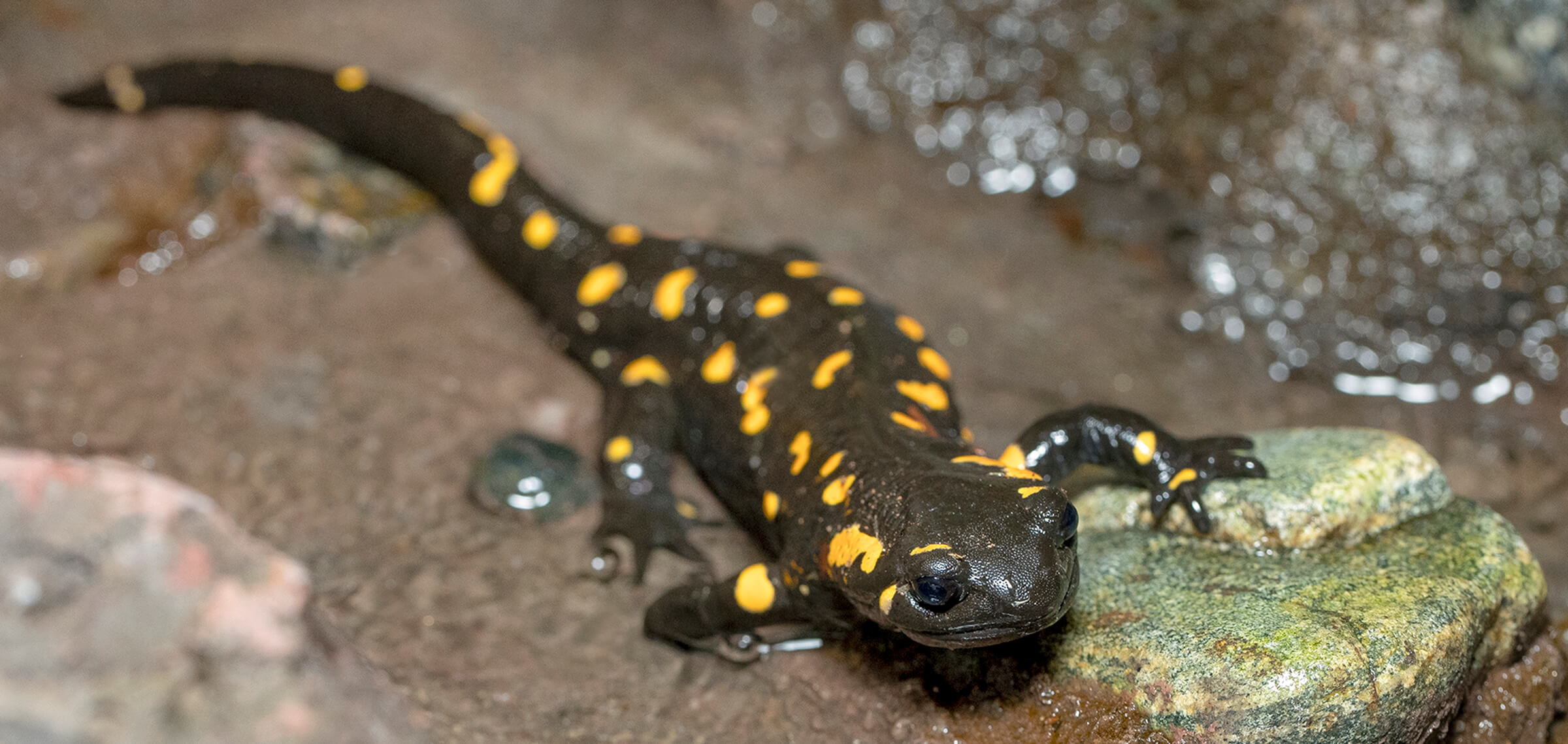
Threats to Salamanders
All species of salamanders face a variety of threats in their native habitats, including habitat destruction or deterioration caused by increased human development, climate change, and pollution. Salamander skin can quickly absorb chemicals from polluted water or runoff from agriculture and lawn care chemicals. “Even little things tend to have a major impact on these species,” Brett said.
Invasive species can also devastate salamander populations. For example, trout are being added in many streams to encourage sportfishing—but those introduced fish are eating small salamanders and salamander eggs (and other native species), sometimes wiping out local populations. Other detrimental invasive species include non-native crayfish and the African clawed frog, a species that not only kills smaller amphibians, but is believed to have introduced the devastating Batachochytrium dendrobatidis, known as chytrid fungus, that has led to the extinction of 200 frog species worldwide.
While overcollecting of salamanders for the pet trade has led to a decrease in populations of many species around the world, it also has brought salamander species from one continent to another, sometimes with damaging results for native populations. Asian newts imported to Europe in 2013 spread a salamander-specific form of chytrid—Batachochytrium salamandrivorans, known as Bsal for short—to native salamanders in the Netherlands, and later to Belgium and Germany. “The fungus did not affect the Asian newt species, but it killed thousands of European salamanders,” Brett said. “Lungless salamanders need their skin to respire, and skin lesions caused by chytrid make that difficult to impossible.” The outbreak of Bsal in Europe led the US Fish and Wildlife Service to impose a temporary ban on importation of more than 200 species of newts and salamanders to the US. “There has been some discussion about overturning the ban, and a lot of concern about what could happen in the US if that occurs,” Brett said.
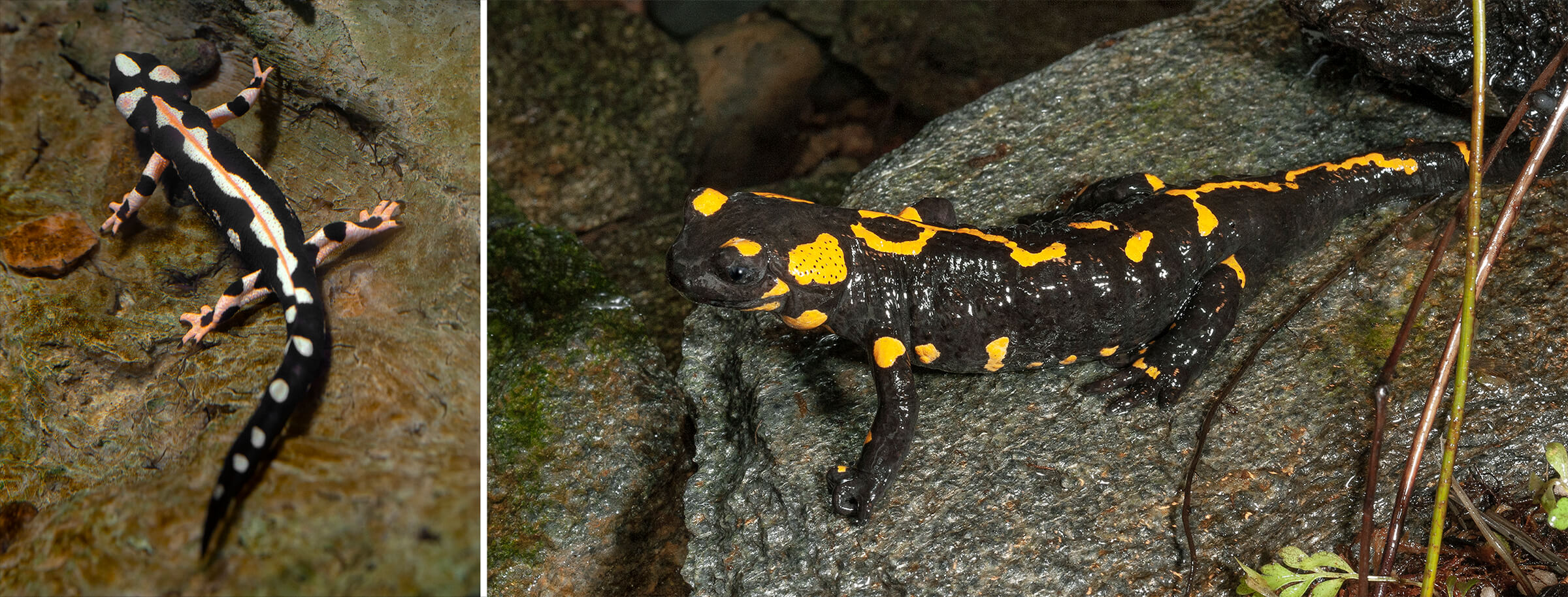
DID YOU KNOW?
What’s the difference between “newts” (like the Kaiser newt at left) and “salamanders” (like the European fire salamander at right)? Salamander is the name for an entire group, or scientific order, of amphibians that have tails as adults. Newts are salamanders, and the word “newt” has traditionally been used to describe salamander species that spend most of their time on land or in trees, instead of in or near the water—and newts often have drier, rough or bumpy skin. However, not all salamanders that are given the newt name differ significantly from other salamanders, Brett said. “It’s almost as if someone decided ‘this salamander is so cool, we’re going to call it a newt.’”
Support Your Local Salamander
While many species of salamanders worldwide are categorized as vulnerable, threatened, or endangered, the truth is that researchers really don’t have enough information to know precisely how many are left, Brett explained. “Some species go decades without ever being seen, and then one day get rediscovered. So, they are hard to count, and it’s hard to know the extent of endangered species.”
The best way for people to help salamanders is to learn more about them, Brett said. “Find out what you have right in your own backyard. You won’t likely see them if you aren’t looking for them.” One important way to help salamanders is to avoid using pesticides in your yard. Something that is sprayed on a plant will run off when it rains or the plant gets watered, and those chemicals may enter the tiny pools of water that salamanders need to reproduce.
Salamanders are unique creatures that play an important part in keeping their habitats healthy. As indicator species, observing them tells us much about the quality of the water and the health of the habitat—and sometimes they warn of serious threats. Ongoing conservation efforts to ensure that suitable salamander habitat continues to exist, along with worldwide efforts to prevent the spread of disease from invasive species, may help these creatures stay alive—and stay top of mind, even if they usually stay out of sight.




